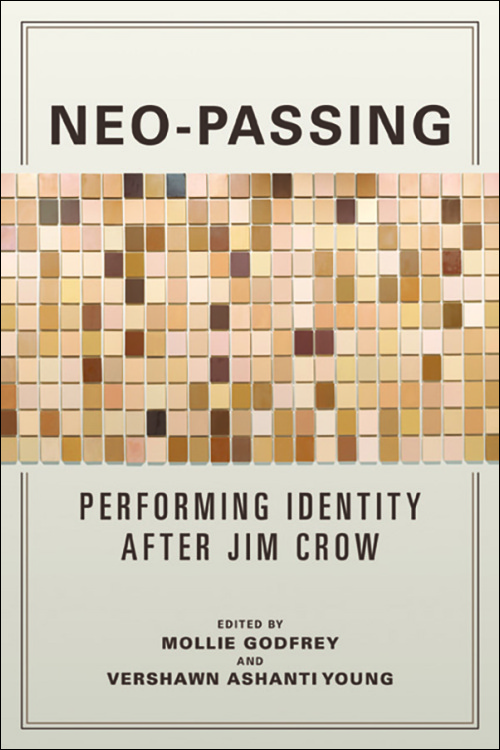Black for a Day: White Fantasies of Race and Empathy by Alisha Gaines (review)Posted in Articles, Book/Video Reviews, Media Archive, Passing, United States on 2019-01-09 22:27Z by Steven |
Black for a Day: White Fantasies of Race and Empathy by Alisha Gaines (review)
Journal of Southern History
The Southern Historical Association
Volume 84, Number 3, August 2018
pages 787-789
DOI: 10.1353/soh.2018.0230
Martha J. Cutter, Professor of English and Africana Studies
University of Connecticut
Black for a Day: White Fantasies of Race and Empathy. By Alisha Gaines. (Chapel Hill: University of North Carolina Press, 2017. Pp. xvi, 213. Paper, $27.95, ISBN 978-1-4696-3283-4; cloth, $80.00, 978-1-4696-3282-7.)
For many years, we have been told that passing is passé. Yet the recent media frenzy surrounding Rachel Dolezal proves that U.S. culture is still vehemently invested in defining the boundaries of whiteness and blackness. When I flashed a PowerPoint slide of Dolezal last spring in my African American literature class, students broke into a cacophony of groans, shouts, and exclamations of “she’s not black!” I was surprised that all but one of my students instantly recognized Dolezal’s image and that virtually everyone had an opinion about her. The plethora of recent books on racial passing—both on African Americans who pass as white and Anglo Americans who pass as black—further demonstrates this topic’s great fascination. Despite postmodern views that race is a construct, scholars often want to pin a racial passer into one category, usually as either a seeker of freedom from racial codes or a betrayer of his or her “true” race. Yet few have considered what passing tells us about our own investments in racial binaries.
I therefore turned with pleasure to Alisha Gaines’s thoughtful book, Black for a Day: White Fantasies of Race and Empathy, which joins a slim list of studies of “‘passing, in reverse'”: the phenomenon of white people who pass for and sometimes claim to become black (p. 17). Other books on this subject include Baz Dreisinger’s Near Black: White-to-Black Passing in American Culture (Amherst, Mass., 2008) and some chapters in Julie Cary Nerad’s edited collection, Passing Interest: Racial Passing in US Novels, Memoirs, Television, and Film, 1990–2010 (Albany, N.Y., 2014). Gaines mentions only one of these works, although I trust that she has consulted both of them.
Gaines’s book is well written and compelling. Her argument that white people’s attempts at “cross-racial empathy” and identification often fail because of their refusal to consider the larger structural and institutional causes of racism is certainly sound (p. 8). Moreover, her use of archival sources is exemplary. I have written about white-to-black passing, yet I still learned much factual information about the passers she studies, including Ray Sprigle, a journalist who published In the Land of Jim Crow (1949); John Howard Griffin, whose book Black Like Me (1961) eclipsed the accounts of all other would-be white passers; Grace Halsell, a white woman and a journalist who took on Griffin’s mantle and published Soul Sister (1969); and finally, the families who switched races in the six-episode television series Black. White. (2006). The book concludes with a short examination of Rachel Dolezal, whom Gaines refuses to consider as “transracial” because the theorization of this term “falls apart” (p. 170). She explains that “blackness becomes the space of racial play, performance, and affect, whereas whiteness does not” (p. 170). This ignores that some light-skinned African Americans did play with whiteness (Jean Toomer, for example) and that some white people crossed over into blackness never to come back (Clarence King and Mezz Mezzrow, for instance). Gaines focuses on creating a genealogy of “temporary black individuals operating under the alibi of racial empathy” in order to illustrate the frequent failure of cross-racial empathy and intimacy (p. 8). Still, I found myself wondering what conclusions Gaines might have reached had she looked at less famous individuals who passed permanently into blackness.
As I have argued elsewhere, passing is a slippery term with roots in deceit and disguise, magic and transformation. The examples Gaines has chosen to include support her argument that temporary assumptions of blackness cannot lead to structural or institutional change. The book might have benefited from a deeper excavation of previous scholarship on white-to-black passing and empathy, but even so, Gaines offers a valuable assessment of how white people problematically inhabit the…
Read or purchase the article here.

